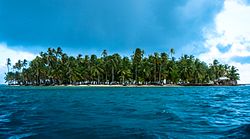
Guna Yala, formerly known as San Blas, is a comarca indígena in northeast Panama. Guna Yala is home to the indigenous people known as the Gunas. Its capital is Gaigirgordub. It is bounded on the north by the Caribbean Sea, on the south by the Darién Province and Emberá-Wounaan, on the east by Colombia, and on the west by the province of Colón.

The Archipelago of Saint Andrew, Providence, and Saint Catherine, or alternatively The Raizal Islands, is an archipelago in Caribbean Sea within the English-speaking West Indies, consisting of two island groups and eight outlying banks and reefs; approximately 292 mi south-west of Jamaica, or 482 mi north-west of mainland Colombia. The largest island of the archipelago is called Saint Andrew and its capital is San Andrés, and the other large island is Providence and Saint Catherine which lies to the north-east of Saint Andrew, and its capital is Saint Elizabeth.

The Guna are an indigenous people of Panama and Colombia. Guna people live in three politically autonomous comarcas or autonomous reservations in Panama, and in a few small villages in Colombia. There are also communities of Guna people in Panama City, Colón, and other cities. Most Guna live on small islands off the coast of the comarca of Guna Yala known as the San Blas Islands. The other two Guna comarcas in Panama are Kuna de Madugandí and Kuna de Wargandí. They are Guna-speaking people who once occupied the central region of what is now Panama and the neighboring San Blas Islands and still survive in marginal areas.
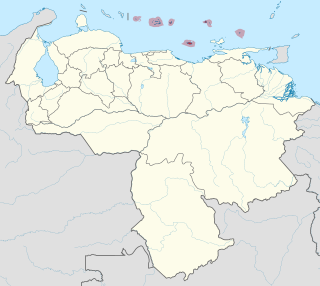
The Federal Dependencies of Venezuela encompass most of Venezuela's offshore islands in the Caribbean Sea and the Gulf of Venezuela, excluding those islands that form the State of Nueva Esparta and some Caribbean coastal islands that are integrated with nearby states. These islands, with a total area of 342 square kilometres, are sparsely populated – according to the preliminary results of the 2011 Census only 2,155 people live there permanently, with another hundred from Margarita Island who live there seasonally to engage in fishing. Local government is officially under the authority of Central government in Caracas, although de facto power is often held by the heads of the sparse and somewhat isolated communities that decorate the territories.
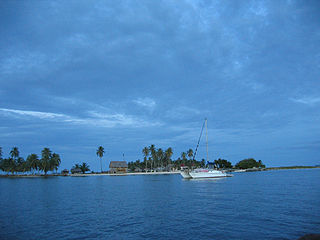
Gaigirgordub, called El Porvenir until July 1, 2016, is the capital of the Panamanian comarca of Guna Yala. The settlement is located on a small island and contains a landing strip, a museum, a hotel, government offices, and an artisans' cooperative. There is also a small beach.

The San Blas Islands of Panama is an archipelago comprising approximately 365 islands and cays, of which 49 are inhabited. They lie off the north coast of the Isthmus of Panama, east of the Panama Canal. A part of the comarca (district) Guna Yala along the Caribbean coast of Panama, it is home to the Kuna people.
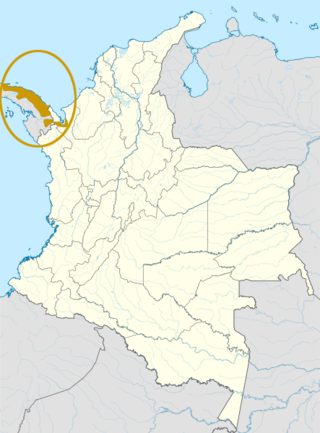
The Kuna language, spoken by the Kuna people of Panama and Colombia, belongs to the Chibchan language family.

The Los Roques Archipelago is a federal dependency of Venezuela consisting of approximately 350 islands, cays, and islets in a total area of 40.61 square kilometers. The archipelago is located 128 kilometers (80 mi) directly north of the port of La Guaira, in the Caribbean Sea.
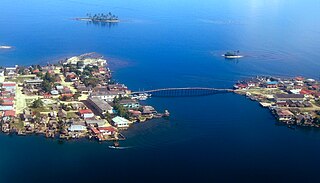
Narganá or Yandup in the Guna language is one of the islands belonging to the Guna Yala, an autonomous territory or comarca in Panama. The culture in Nargana is influenced heavily by Panama and most people there are bilingual speaking both Spanish and the Kuna language. The island has an area of 5.5 hectares and is completely overbuilt, and could be walked around in less than 10 minutes. There is a small hospital and school on the island. The nearest populated island, Corazón de Jesús, is connected to Nargana by a concrete bridge. Both islands are among the most westernized of the San Blas Islands.
Abya Yala is a neologism used by indigenous peoples of the Americas to refer to the American continent. The term is used by indigenous organisations, institutions, and movements as a symbol of identity and respect for the land one inhabits. The increasing usage of the term can be viewed in the context of decolonization, as it serves to create an understanding that "land and discourse, territorio y palabra, cannot be disjointed" and a geography in which a struggle for sovereignty and resistance occurs on an everyday basis for Indigenous communities.
The Colorados Archipelago is a chain of isles and cays on Cuba's north-western coast.

Cartí Sugtupu, also spelled Gardi Sugdub, is an island in the San Blas Archipelago in the Guna Yala province of Panama. It is the southernmost and largest of four populated Carti Islands, and it lies 1200 meters off the northern coast of mainland Panama. The island is densely populated and houses a small harbour and a museum. Its indigenous inhabitants are Guna.

Indigenous peoples of Panama, or Native Panamanians, are the native peoples of Panama. According to the 2010 census, they make up 12.3% of the overall population of 3.4 million, or just over 418,000 people. The Ngäbe and Buglé comprise half of the indigenous peoples of Panama.
Rio Sidra is a densely populated island town in the San Blas Archipelago of the Kuna Yala comarca of Panama. Among the native Guna population, the island is called, Urgandi. The island is 1 kilometre (0.6 mi) off Panama's north coast. Rio Sidra is a municipality or corregimiento of Narganá.

Playón Chico Airport is an airport serving Ukupseni, an island in the San Blas Archipelago in the Guna Yala comarca of Panama.

Ustupu-Ogobsucum Airport is an airport serving the island town of Ustupo in the Guna Yala comarca of Panama. It handles domestic flights and general aviation.

The San Blas Rebellion, Guna Revolution or Revolution of Tule was an uprising by the Kuna, to declare independence, in the San Blas Islands, in February 1925.
Petita Ayarza Pérez is a Panamanian Indigenous political leader and businesswoman. In the 2019 general election, she became the first Guna woman to run for a seat as deputy and be elected to the National Assembly of Panama.
Mormagedup, Moraggedub or Mormaketupu, also called Isla Máquina or Isla Maquina, is a densely populated island in the San Blas Archipelago, a group of islands off the coast of northeast Panama specifically in the Guna Yala Region. The island is part of the municipality or corregimiento of Narganá.
